Evaluating uncertainty of some radiation measurand using Monte Carlo method
Evaluating measurement uncertainty of a physical quantity is a mandatory requirement for
laboratories within the recognition ISO/IEC 17025 certification to access reliability of measured
results. In this work, the uncertainty of ionizing radiation measurements such as air-kerma, personal
dose equivalent was evaluated based on GUM method and Monte Carlo method. An
uncertainty propagation software has been developed for evaluation of the measurement uncertainty
more convenient.
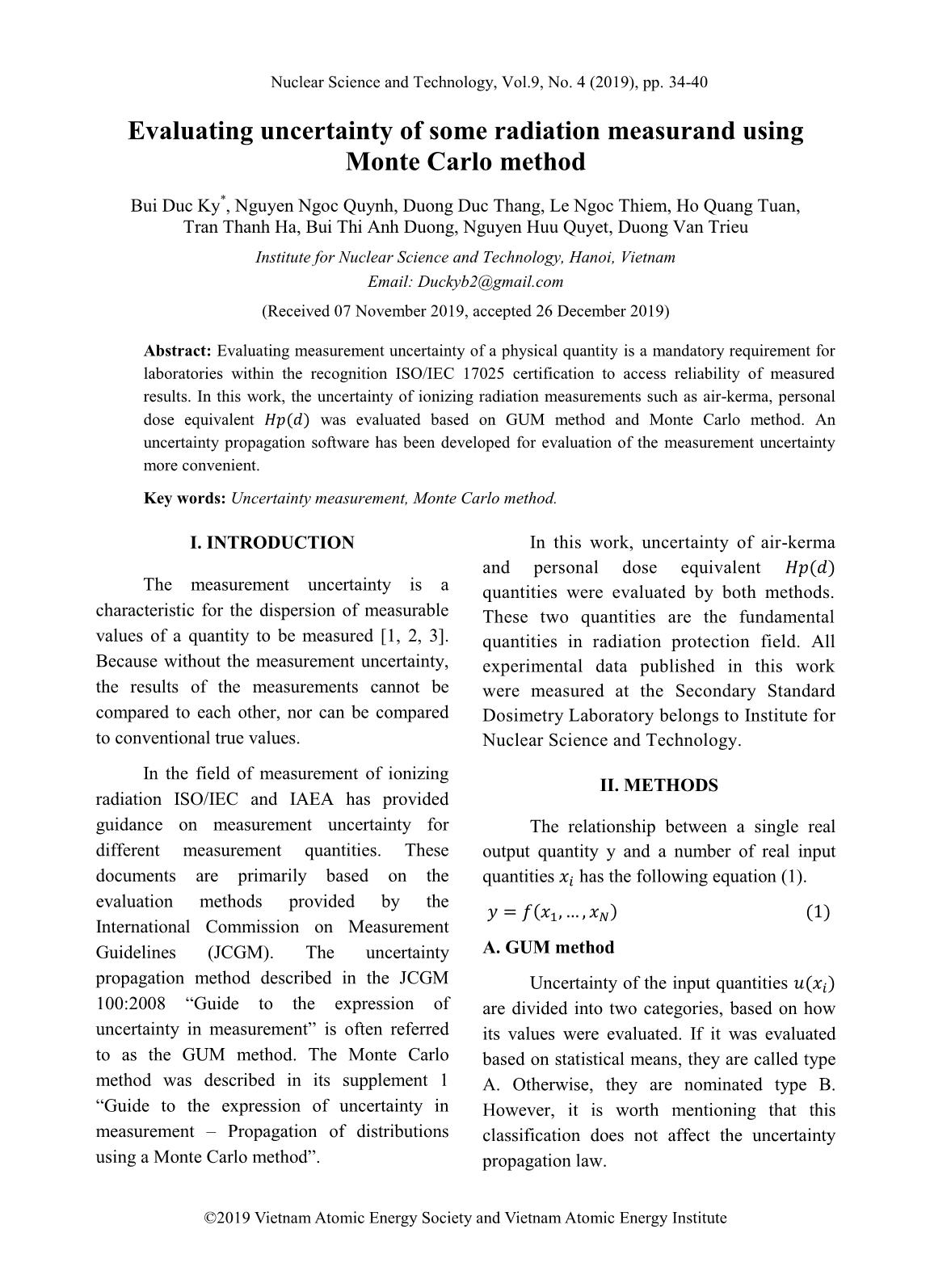
Trang 1
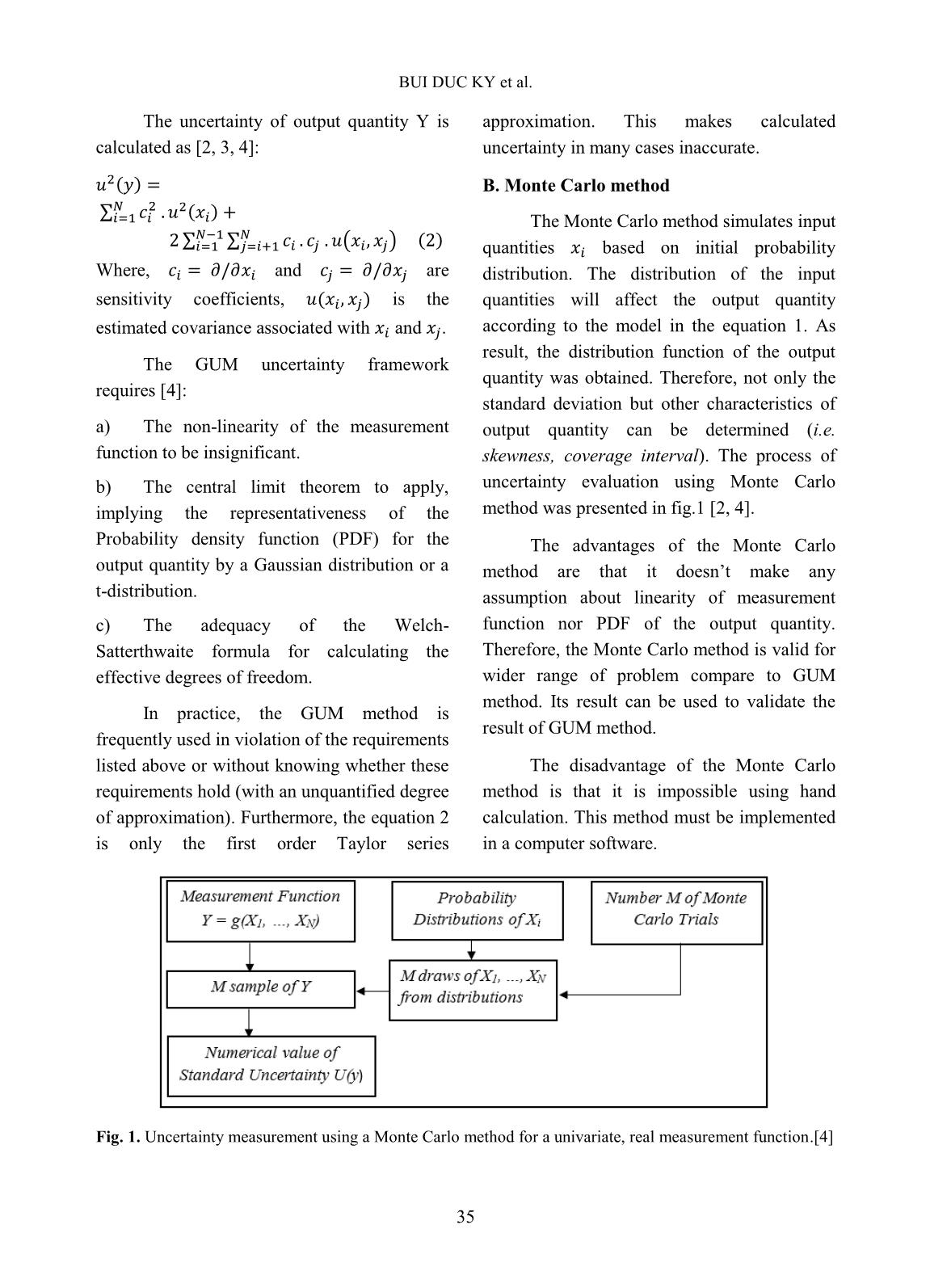
Trang 2
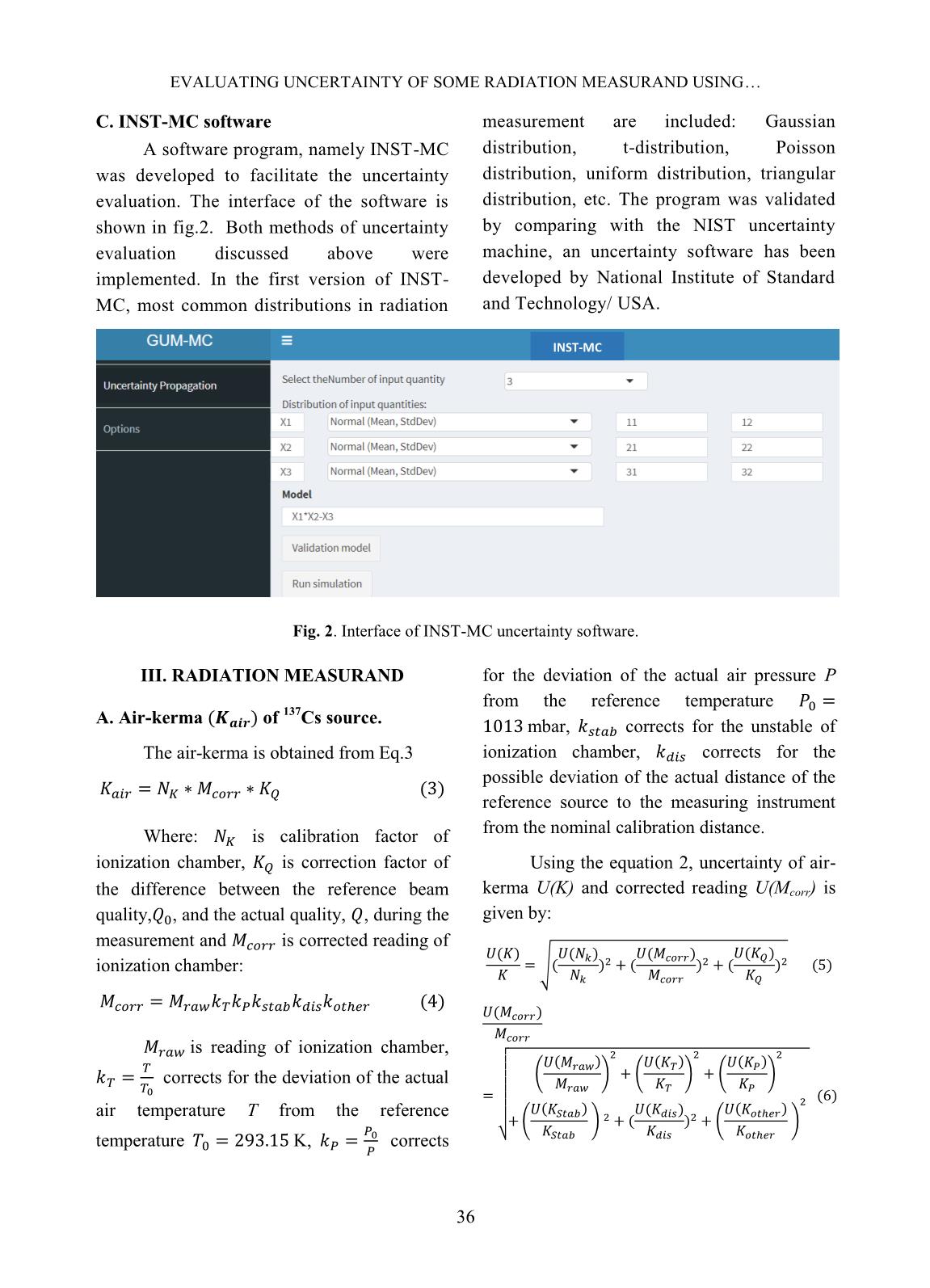
Trang 3
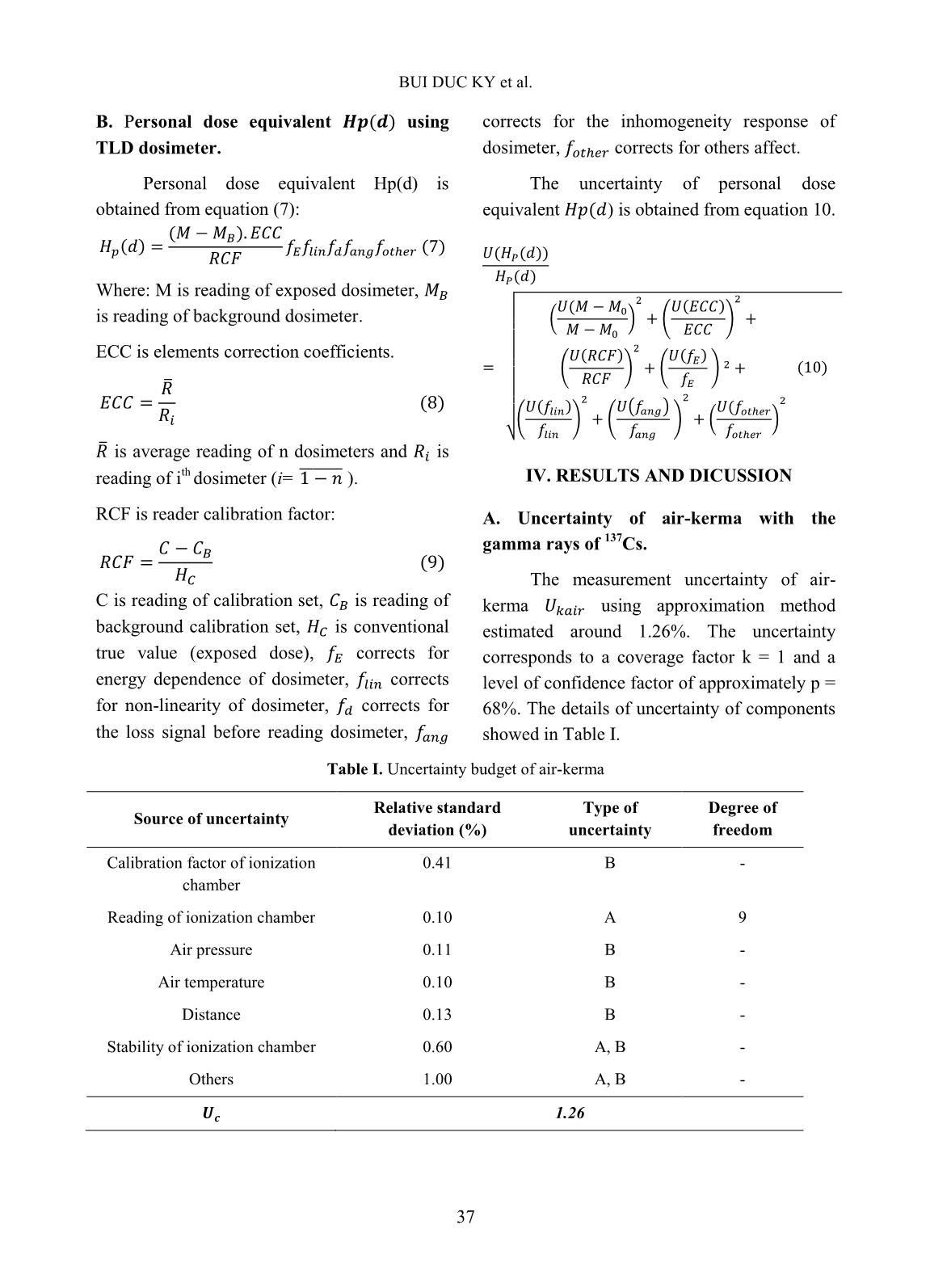
Trang 4
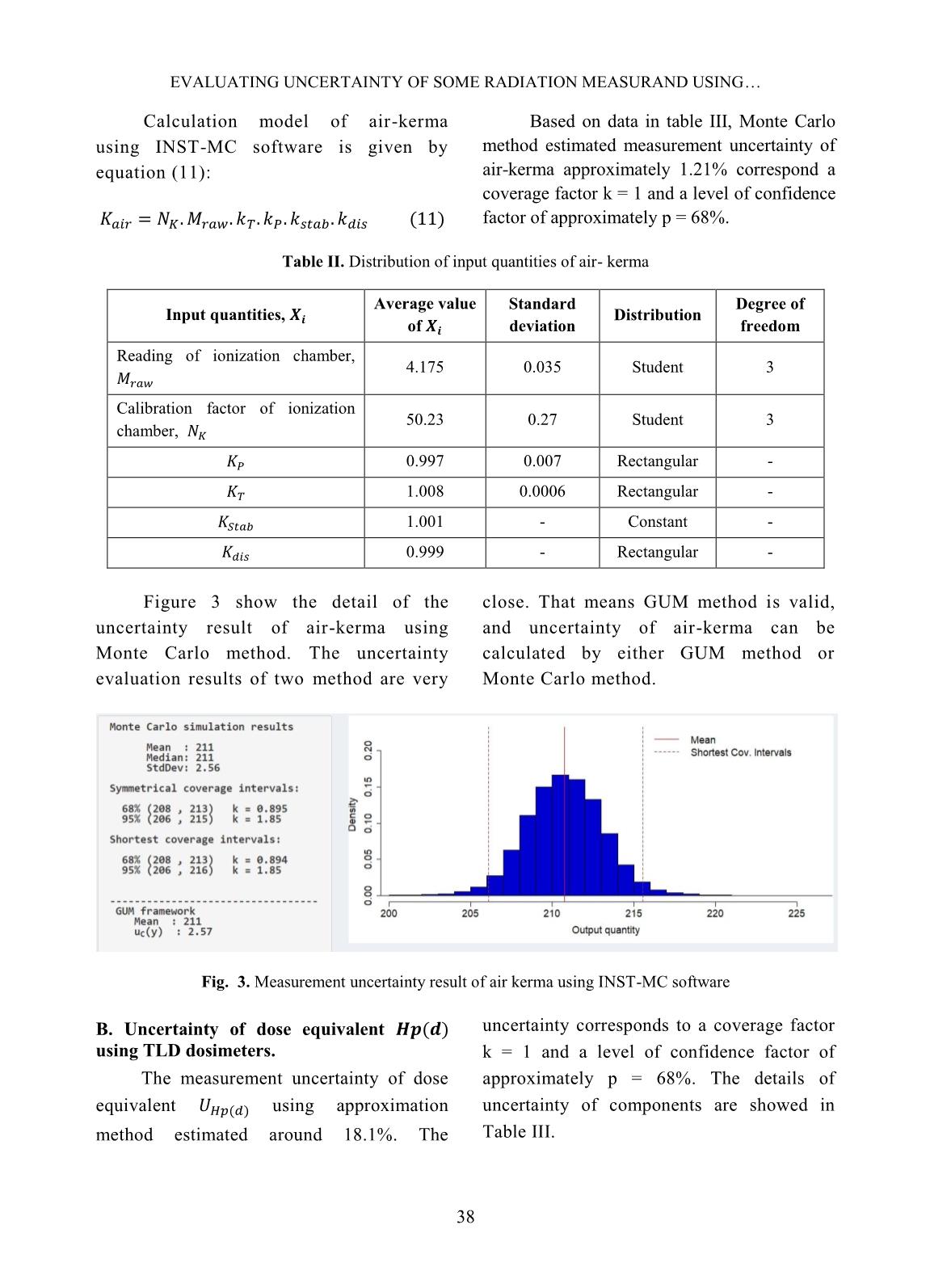
Trang 5
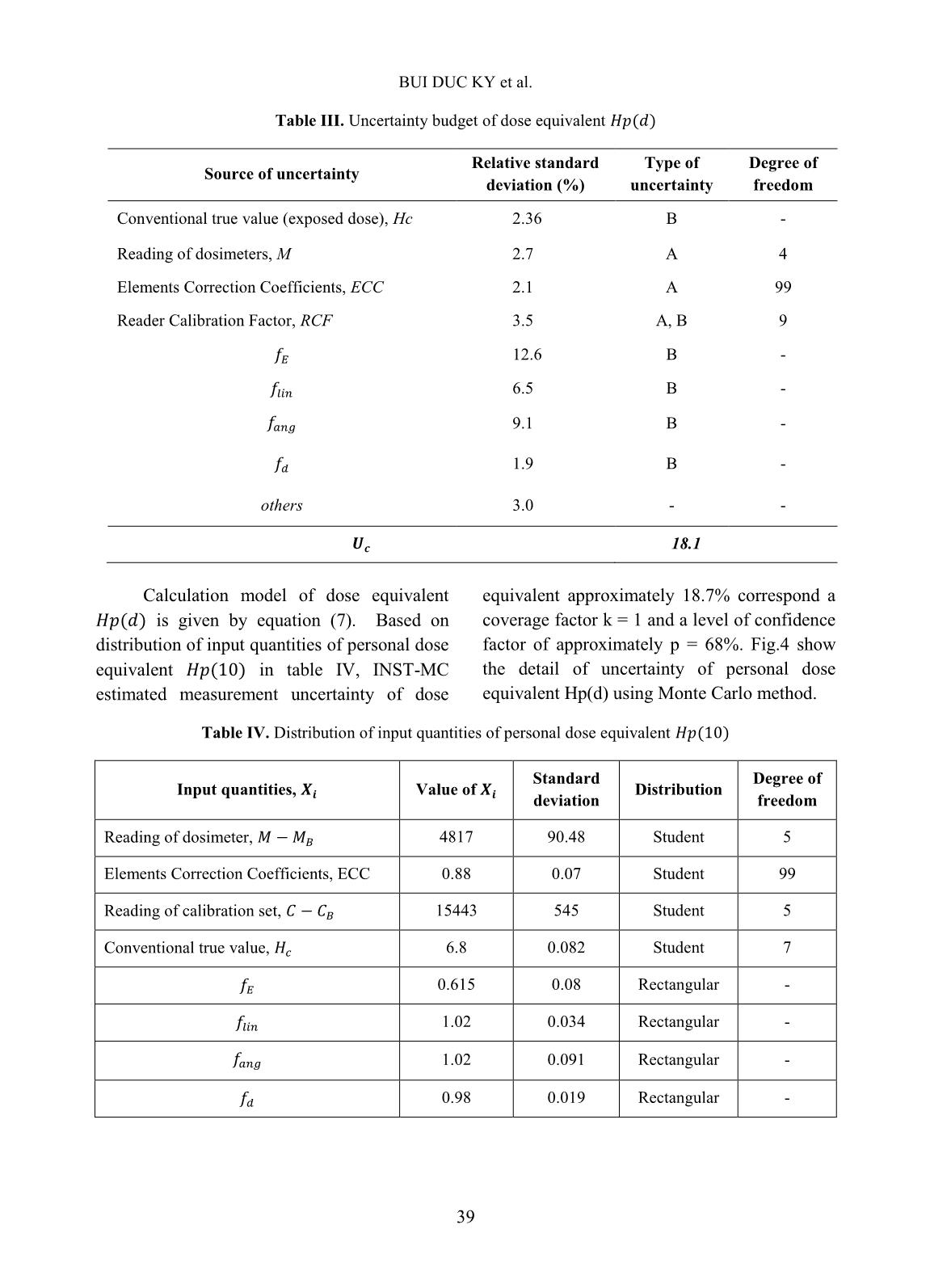
Trang 6
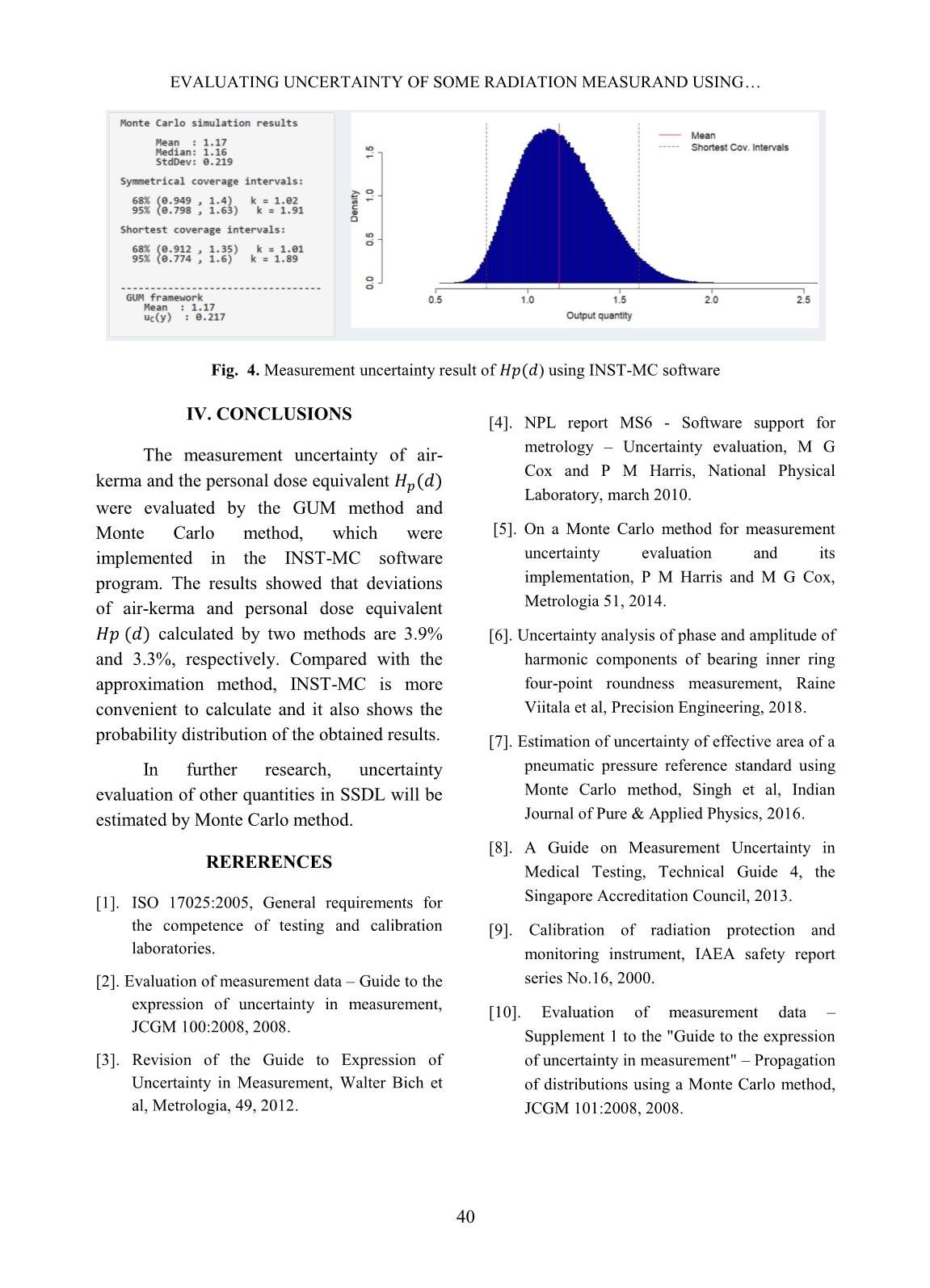
Trang 7
Bạn đang xem tài liệu "Evaluating uncertainty of some radiation measurand using Monte Carlo method", để tải tài liệu gốc về máy hãy click vào nút Download ở trên
Tóm tắt nội dung tài liệu: Evaluating uncertainty of some radiation measurand using Monte Carlo method
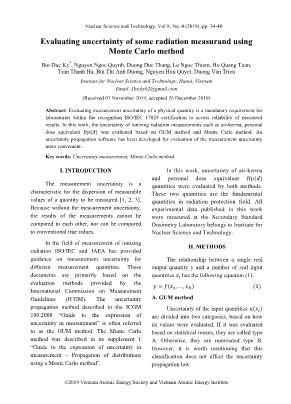
Nuclear Science and Technology, Vol.9, No. 4 (2019), pp. 34-40 ©2019 Vietnam Atomic Energy Society and Vietnam Atomic Energy Institute Evaluating uncertainty of some radiation measurand using Monte Carlo method Bui Duc Ky * , Nguyen Ngoc Quynh, Duong Duc Thang, Le Ngoc Thiem, Ho Quang Tuan, Tran Thanh Ha, Bui Thi Anh Duong, Nguyen Huu Quyet, Duong Van Trieu Institute for Nuclear Science and Technology, Hanoi, Vietnam Email: Duckyb2@gmail.com (Received 07 November 2019, accepted 26 December 2019) Abstract: Evaluating measurement uncertainty of a physical quantity is a mandatory requirement for laboratories within the recognition ISO/IEC 17025 certification to access reliability of measured results. In this work, the uncertainty of ionizing radiation measurements such as air-kerma, personal dose equivalent was evaluated based on GUM method and Monte Carlo method. An uncertainty propagation software has been developed for evaluation of the measurement uncertainty more convenient. Key words: Uncertainty measurement, Monte Carlo method. I. INTRODUCTION The measurement uncertainty is a characteristic for the dispersion of measurable values of a quantity to be measured [1, 2, 3]. Because without the measurement uncertainty, the results of the measurements cannot be compared to each other, nor can be compared to conventional true values. In the field of measurement of ionizing radiation ISO/IEC and IAEA has provided guidance on measurement uncertainty for different measurement quantities. These documents are primarily based on the evaluation methods provided by the International Commission on Measurement Guidelines (JCGM). The uncertainty propagation method described in the JCGM 100:2008 “Guide to the expression of uncertainty in measurement” is often referred to as the GUM method. The Monte Carlo method was described in its supplement 1 “Guide to the expression of uncertainty in measurement – Propagation of distributions using a Monte Carlo method”. In this work, uncertainty of air-kerma and personal dose equivalent quantities were evaluated by both methods. These two quantities are the fundamental quantities in radiation protection field. All experimental data published in this work were measured at the Secondary Standard Dosimetry Laboratory belongs to Institute for Nuclear Science and Technology. II. METHODS The relationship between a single real output quantity y and a number of real input quantities has the following equation (1). A. GUM method Uncertainty of the input quantities are divided into two categories, based on how its values were evaluated. If it was evaluated based on statistical means, they are called type A. Otherwise, they are nominated type B. However, it is worth mentioning that this classification does not affect the uncertainty propagation law. BUI DUC KY et al. 35 The uncertainty of output quantity Y is calculated as [2, 3, 4]: ∑ ∑ ∑ ( ) Where, and are sensitivity coefficients, is the estimated covariance associated with and . The GUM uncertainty framework requires [4]: a) The non-linearity of the measurement function to be insignificant. b) The central limit theorem to apply, implying the representativeness of the Probability density function (PDF) for the output quantity by a Gaussian distribution or a t-distribution. c) The adequacy of the Welch- Satterthwaite formula for calculating the effective degrees of freedom. In practice, the GUM method is frequently used in violation of the requirements listed above or without knowing whether these requirements hold (with an unquantified degree of approximation). Furthermore, the equation 2 is only the first order Taylor series approximation. This makes calculated uncertainty in many cases inaccurate. B. Monte Carlo method The Monte Carlo method simulates input quantities based on initial probability distribution. The distribution of the input quantities will affect the output quantity according to the model in the equation 1. As result, the distribution function of the output quantity was obtained. Therefore, not only the standard deviation but other characteristics of output quantity can be determined (i.e. skewness, coverage interval). The process of uncertainty evaluation using Monte Carlo method was presented in fig.1 [2, 4]. The advantages of the Monte Carlo method are that it doesn’t make any assumption about linearity of measurement function nor PDF of the output quantity. Therefore, the Monte Carlo method is valid for wider range of problem compare to GUM method. Its result can be used to validate the result of GUM method. The disadvantage of the Monte Carlo method is that it is impossible using hand calculation. This method must be implemented in a computer software. Fig. 1. Uncertainty measurement using a Monte Carlo method for a univariate, real measurement function.[4] EVALUATING UNCERTAINTY OF SOME RADIATION MEASURAND USING 36 C. INST-MC software A software program, namely INST-MC was developed to facilitate the uncertainty evaluation. The interface of the software is shown in fig.2. Both methods of uncertainty evaluation discussed above were implemented. In the first version of INST- MC, most common distributions in radiation measurement are included: Gaussian distribution, t-distribution, Poisson distribution, uniform distribution, triangular distribution, etc. The program was validated by comparing with the NIST uncertainty machine, an uncertainty software has been developed by National Institute of Standard and Technology/ USA. Fig. 2. Interface of INST-MC uncertainty software. III. RADIATION MEASURAND A. Air-kerma of 137 Cs source. The air-kerma is obtained from Eq.3 Where: is calibration factor of ionization chamber, is correction factor of the difference between the reference beam quality, , and the actual quality, , during the measurement and is corrected reading of ionization chamber: is reading of ionization chamber, corrects for the deviation of the actual air temperature T from the reference temperature K, corrects for the deviation of the actual air pressure P from the reference temperature mbar, corrects for the unstable of ionization chamber, corrects for the possible deviation of the actual distance of the reference source to the measuring instrument from the nominal calibration distance. Using the equation 2, uncertainty of air- kerma U(K) and corrected reading U(Mcorr) is given by: √ √ ( ) ( ) ( ) ( ) ( ) INST-MC BUI DUC KY et al. 37 B. Personal dose equivalent using TLD dosimeter. Personal dose equivalent Hp(d) is obtained from equation (7): Where: M is reading of exposed dosimeter, is reading of background dosimeter. ECC is elements correction coefficients. ̅ ̅ is average reading of n dosimeters and is reading of i th dosimeter (i= ̅̅ ̅̅ ̅̅ ̅ ). RCF is reader calibration factor: C is reading of calibration set, is reading of background calibration set, is conventional true value (exposed dose), corrects for energy dependence of dosimeter, corrects for non-linearity of dosimeter, corrects for the loss signal before reading dosimeter, corrects for the inhomogeneity response of dosimeter, corrects for others affect. The uncertainty of personal dose equivalent ) is obtained from equation 10. √ ( ) ( ) ( ) ( ) ( ) ( ( ) ) ( ) IV. RESULTS AND DICUSSION A. Uncertainty of air-kerma with the gamma rays of 137 Cs. The measurement uncertainty of air- kerma using approximation method estimated around 1.26%. The uncertainty corresponds to a coverage factor k = 1 and a level of confidence factor of approximately p = 68%. The details of uncertainty of components showed in Table I. Table I. Uncertainty budget of air-kerma Source of uncertainty Relative standard deviation (%) Type of uncertainty Degree of freedom Calibration factor of ionization chamber 0.41 B - Reading of ionization chamber 0.10 A 9 Air pressure 0.11 B - Air temperature 0.10 B - Distance 0.13 B - Stability of ionization chamber 0.60 A, B - Others 1.00 A, B - 1.26 EVALUATING UNCERTAINTY OF SOME RADIATION MEASURAND USING 38 Calculation model of air-kerma using INST-MC software is given by equation (11): Based on data in table III, Monte Carlo method estimated measurement uncertainty of air-kerma approximately 1.21% correspond a coverage factor k = 1 and a level of confidence factor of approximately p = 68%. Table II. Distribution of input quantities of air- kerma Input quantities, Average value of Standard deviation Distribution Degree of freedom Reading of ionization chamber, 4.175 0.035 Student 3 Calibration factor of ionization chamber, 50.23 0.27 Student 3 0.997 0.007 Rectangular - 1.008 0.0006 Rectangular - 1.001 - Constant - 0.999 - Rectangular - Figure 3 show the detail of the uncertainty result of air-kerma using Monte Carlo method. The uncertainty evaluation results of two method are very close. That means GUM method is valid, and uncertainty of air-kerma can be calculated by either GUM method or Monte Carlo method. Fig. 3. Measurement uncertainty result of air kerma using INST-MC software B. Uncertainty of dose equivalent using TLD dosimeters. The measurement uncertainty of dose equivalent using approximation method estimated around 18.1%. The uncertainty corresponds to a coverage factor k = 1 and a level of confidence factor of approximately p = 68%. The details of uncertainty of components are showed in Table III. BUI DUC KY et al. 39 Table III. Uncertainty budget of dose equivalent Source of uncertainty Relative standard deviation (%) Type of uncertainty Degree of freedom Conventional true value (exposed dose), Hc 2.36 B - Reading of dosimeters, M 2.7 A 4 Elements Correction Coefficients, ECC 2.1 A 99 Reader Calibration Factor, RCF 3.5 A, B 9 12.6 B - 6.5 B - 9.1 B - 1.9 B - others 3.0 - - 18.1 Calculation model of dose equivalent is given by equation (7). Based on distribution of input quantities of personal dose equivalent in table IV, INST-MC estimated measurement uncertainty of dose equivalent approximately 18.7% correspond a coverage factor k = 1 and a level of confidence factor of approximately p = 68%. Fig.4 show the detail of uncertainty of personal dose equivalent Hp(d) using Monte Carlo method. Table IV. Distribution of input quantities of personal dose equivalent Input quantities, Value of Standard deviation Distribution Degree of freedom Reading of dosimeter, 4817 90.48 Student 5 Elements Correction Coefficients, ECC 0.88 0.07 Student 99 Reading of calibration set, 15443 545 Student 5 Conventional true value, 6.8 0.082 Student 7 0.615 0.08 Rectangular - 1.02 0.034 Rectangular - 1.02 0.091 Rectangular - 0.98 0.019 Rectangular - EVALUATING UNCERTAINTY OF SOME RADIATION MEASURAND USING 40 Fig. 4. Measurement uncertainty result of ) using INST-MC software IV. CONCLUSIONS The measurement uncertainty of air- kerma and the personal dose equivalent were evaluated by the GUM method and Monte Carlo method, which were implemented in the INST-MC software program. The results showed that deviations of air-kerma and personal dose equivalent calculated by two methods are 3.9% and 3.3%, respectively. Compared with the approximation method, INST-MC is more convenient to calculate and it also shows the probability distribution of the obtained results. In further research, uncertainty evaluation of other quantities in SSDL will be estimated by Monte Carlo method. RERERENCES [1]. ISO 17025:2005, General requirements for the competence of testing and calibration laboratories. [2]. Evaluation of measurement data – Guide to the expression of uncertainty in measurement, JCGM 100:2008, 2008. [3]. Revision of the Guide to Expression of Uncertainty in Measurement, Walter Bich et al, Metrologia, 49, 2012. [4]. NPL report MS6 - Software support for metrology – Uncertainty evaluation, M G Cox and P M Harris, National Physical Laboratory, march 2010. [5]. On a Monte Carlo method for measurement uncertainty evaluation and its implementation, P M Harris and M G Cox, Metrologia 51, 2014. [6]. Uncertainty analysis of phase and amplitude of harmonic components of bearing inner ring four-point roundness measurement, Raine Viitala et al, Precision Engineering, 2018. [7]. Estimation of uncertainty of effective area of a pneumatic pressure reference standard using Monte Carlo method, Singh et al, Indian Journal of Pure & Applied Physics, 2016. [8]. A Guide on Measurement Uncertainty in Medical Testing, Technical Guide 4, the Singapore Accreditation Council, 2013. [9]. Calibration of radiation protection and monitoring instrument, IAEA safety report series No.16, 2000. [10]. Evaluation of measurement data – Supplement 1 to the "Guide to the expression of uncertainty in measurement" – Propagation of distributions using a Monte Carlo method, JCGM 101:2008, 2008.
File đính kèm:
 evaluating_uncertainty_of_some_radiation_measurand_using_mon.pdf
evaluating_uncertainty_of_some_radiation_measurand_using_mon.pdf

